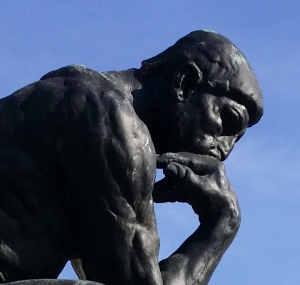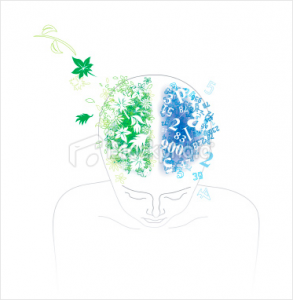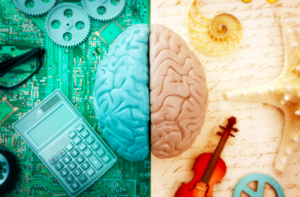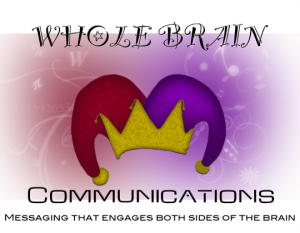cre·a·tiv·i·ty / krēāˈtivədē/ noun:
"The use of imagination or original ideas to create something; inventiveness." – oxforddictionaries.com
"The process of having original ideas that have value." – Sir Ken Robinson
______________________________________________________________________
In a LinkedIn discussion group a while ago, a question was posed, “Which is more important: critical thinking or creative thinking?”
I was a bit taken aback by the question, since I can't really imagine one without the other. In my world-view, they should inform one another. In fact, I believe that even construing these as two independent and unrelated types of thinking is a false dichotomy. Unfortunately, it is a widely prevalent one that has been the basis of some of the limited and short-term thinking behind many of our organizational, economic, social, and environmental crises today.
Our world needs organizations filled with creative thinkers with strong skills in critical analysis, as well as analytical thinkers adept in creative ideation. And we can achieve this. We all have both sets of capabilities. They are two sides of the same coin.
 Thinking with our Whole Brains
Thinking with our Whole Brains
We humans are born with brains with two hemispheres for good reason:
- Among its other functions, the “left brain” helps us with logical and sequential reasoning, vocabulary and grammar, mathematical calculations, planning, and detail.
- While the right hemisphere helps with spatial, contextual, empathetic, kinesthetic, artistic, and creative thinking, and synthesis. It looks for patterns and connections, even those that may not be readily apparent.
Many of us may lean towards one type of thinking, but it’s a matter of choice (including the choice to resist peer pressure) as to whether we primarily exercise one hemisphere, or use our entire [and for believers among you, “God-given”] brain and apply what some refer to as "whole brain thinking." (Hermann Solutions and author Dan Pink's talks on A Whole New Mind.)
From a recent Psychology Today article, "The highest levels of creativity require both divergent thinking" (the ability to generate multiple ideas and possible solutions) "and convergent thinking" (the ability to deduce a single correct factual answer) "[which has] long been known in creativity research. [In the] Geneplore model, creativity involves a cyclical process of generating ideas and then systematically working out which ideas are most fruitful and implementing them."
How our collective creative imaginations became buried alive
The northern European-dominated U.S. culture and its current public education system strongly favors “left-brain” linear thinking. To explore the effects of this approach to education on the innate creative imaginations of children, in the 1960s Dr. George Land led a multi-year NASA-funded study. 1,600 children in a Head Start program were tested on their divergent or “out of the box” thinking abilities.
- Of children 4-5 years old, 98% tested at the “genius” level for divergent thinking.
- But by ages 14-15, the numbers had gone down to 12%! These youngsters had not lost their capacities for divergent thinking, but peer pressure to conform in order to a) “fit in” and not seem “weird*” to other kids, and/or to b) give “the one right answer” in school (convergent thinking) had already trained these adolescents to suppress their own creative imaginations.
- By age 25, only 2% of 280,000 adults tested in the genius range. –Woe is us! (George Land's TED Talk.)
Land wrote, "What we have concluded is that non-creative behavior is learned."
According to Human Resource expert John Putzier in his highly engaging book, Get Weird: 101 Innovative Ways to Make Your Company a Great Place to Work, the 2% of adults who do manage to hold onto their divergent thinking abilities are often considered “too weird”* to be hired by many employers as they don't fit the expected molds. Or when they do find employment, they often learn to keep their heads down and their ideas to themselves.
*(Putzier says the word “weird” is intended as a pejorative often used as shorthand for anything considered to be “different.”)
The case for Both/And….
Unlike merely “imaginative” musings, (as with the definitions at the top of this article) some define creativity as a form of thinking that presents "the right solutions at the right time." Given the opportunity, these can then result in innovation.
Solid analysis is a prerequisite for creative solutions:
- Recognizing the internal and external dimensions and factors of a problem
- Exploring the components of possible solutions
- The art of successfully inspiring and persuading others
The most brilliant thinkers and innovators have built their imaginative creations on foundations of significant amounts of critical thinking. Truly creative thinking results from an intersection of analysis, imagination, and synthesis. And when given the requisite support, innovation can be the result.
It is no surprise that the standout leaders in the 2010 IBM CEO study (see summary in previous post) who fostered creative thinking throughout their organizations also found that increased efficiency and profitability resulted. The two equal and complementary hemispheres of our brain exist together to be used together. Either half used in isolation, is limited and far less effective:
- Ungrounded imaginative musings that don’t reflect interrelationships and what is truly possible go nowhere.
- Analytical scrutiny bereft of exploring creative possibilities and alternatives to what it views as “current reality” often overlook the larger picture and more comprehensive solutions.
The most effective problem solving requires creative thinking grounded in critical analysis — a brilliant, inspiring, (and perhaps inspired) union.
— Creative thinking is often the smartest thinking!
Originally written February 2011. Revised January 2018.

 How would you feel if many people thought you were the smartest person in history? How might your life be different if you actually were that intelligent? Although we often think of Albert Einstein as one of the smartest people ever, we don’t investigate what it was that made him so. People who speak highly of him often attribute his genius to some mysterious gift. They don’t believe his smarts came from a certain attitude about learning. I believe you can recreate some of his habits to get smarter and find more rewarding work.
How would you feel if many people thought you were the smartest person in history? How might your life be different if you actually were that intelligent? Although we often think of Albert Einstein as one of the smartest people ever, we don’t investigate what it was that made him so. People who speak highly of him often attribute his genius to some mysterious gift. They don’t believe his smarts came from a certain attitude about learning. I believe you can recreate some of his habits to get smarter and find more rewarding work.


